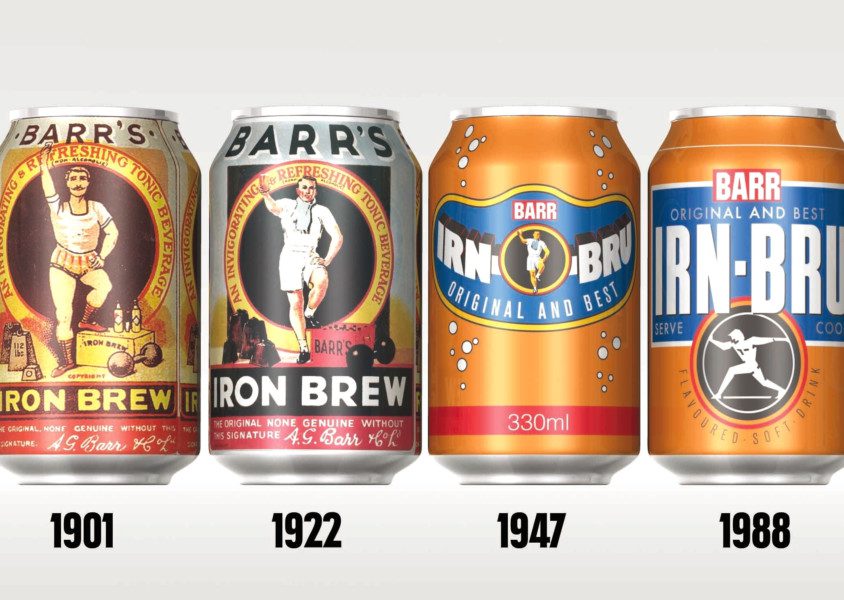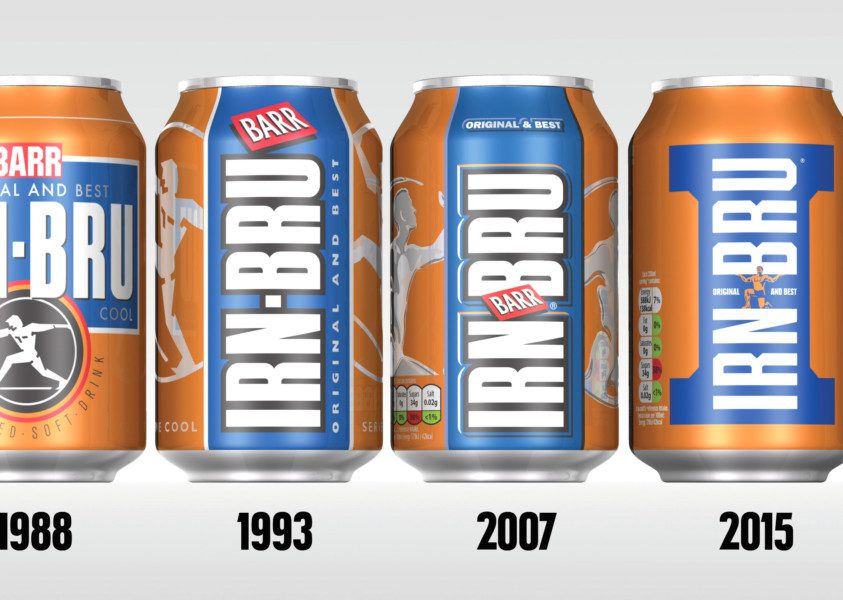
The recent controversy surrounding the change of a much loved recipe which has become part of Scotland's cultural fabric since it was first launched in 1901 highlights the affection Scots have with a drink that has become as important to them as whisky.


A time line of Barr's Irn-Bru designs starting in 1901. PIC: Contributed.
A carbonated soft drink with orange artificial colourings, it is made to a secret recipe - known by only three directors on the Barrs board - of 32 flavours.
The listed ingredients include: Carbonated Water, Sugar, Citric Acid, the aformentioned flavourings (including Caffeine, Ammonium Ferric Citrate & Quinine), the newly added sweeteners (Aspartame, Acesulfame K), a preservative (E211), and of course those wonderful colours (Sunset Yellow FCF, Ponceau 4R).
Rumours circulated in the Scottish Muslim community in 2005, that Irn Bru also contained alcohol, meaning that as many of them feared, they may no longer be able to continue to drink the beloved soft drink.


Irn Bru has recently unveiled its new design.
Though Barrs went on to confirm that it did contain alcohol, it was such a small amount as to be virtually negligible, meaning everyone, including the Muslim community could continue to enjoy Irn-Bru.
Sadly, though many classic ads enthused that the fizzy juice was made from ‘girders’, this isn't true though it does contain iron - with the 0.002 per cent ammonium ferric citrate listed among its ingredients a food additive containing iron hydroxide.
Perhaps the girders were in fact a reference to the rust colour of the drink.
Beginning life as 'Aerated Waters', as soft drinks were known back then, and originally known as 'Strachan’s Brew', the now famous drink was created by Robert Barr and his two sons Robert and Andrew - who would go to become the founding member of AG Barr, a company that fall into his younger brother William's hands when he died in 1903.
Former chairman and one of the recipe trinity, Robin Barr, is William's grandson.
The drink gained popularity through its successful ad campaigns, first in linking with Glasgow's shipping and engineering heritage with its girders campaign and then in its strongman logo - known as the iconic “Highland athlete” - which featured on the cans and was portrayed by Highland Games athlete Adam Brown.
The name change first from Strachan's Brew to Iron Brew, was followed by Irn-Bru in 1947 after a change in laws a year earlier forced the company to re-think the name as the popular drink is not physically brewed.
No-one is really sure where the Iron Brew name came from, though one man is certain it was invented in America and laterally adopted by Barrs along with the strongman logo.
Though the company have not denied the theory, a spokesperson for AG Barr did say: "There’s no doubt there have been Iron Brews in the past, but for us there is only one real IRN-BRU."
Irn-Bru is also manufactured in five factories in Russia alone, and is manufactured under licence in Canada, the USA and Norway in 2008.
The drink, along with some other Barr products, is exported to Spain, the Netherlands, Germany, Gibraltar, Iceland, Belgium, Poland, Malta, Greece, Cyprus and parts of Africa and Asia.
In Scotland, and by extension the UK, it continues to be as popular as ever - with it out selling every other soft drink north of the border (though it remains to be seen how the recipe change will affect sales) and coming in third behind Coca Cola and Pepsi UK wide.
Read more at: https://foodanddrink.scotsman.com/drink/10-facts-about-irn-bru/


